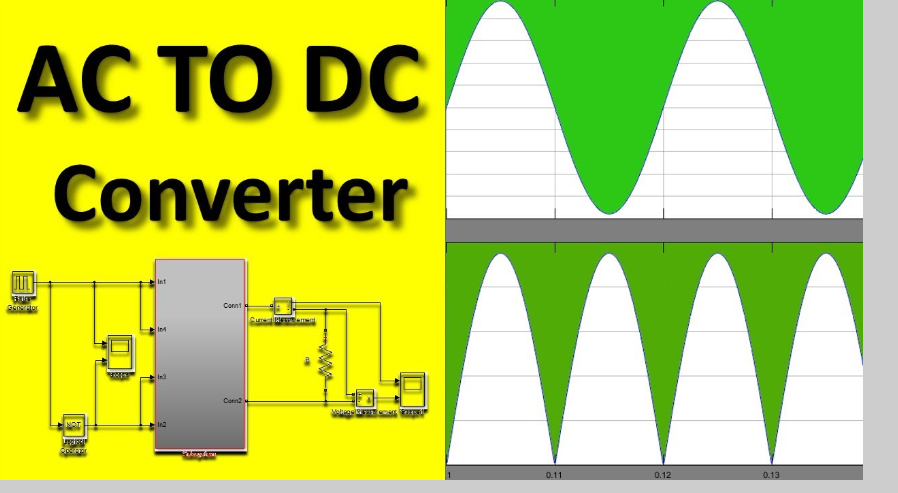AC to DC Converter: Converting Alternating Current to Direct Power
Heading 1: Introduction to AC to DC Conversion
The conversion of alternating current (AC) to direct current (DC) is a fundamental process in modern electrical engineering. It plays a crucial role in various applications, from powering electronic devices to transmitting electricity over long distances. In this comprehensive article, we will explore the principles, types, and significance of AC to DC converters.
Heading 2: Understanding Alternating Current (AC) and Direct Current (DC)
Before delving into AC to DC converters, it’s essential to grasp the fundamental differences between AC and DC electrical systems.
AC (Alternating Current): Alternating current is characterized by a continuous and periodic reversal of the direction of electric current flow. It is the standard form of electricity supplied to homes and businesses. AC voltage oscillates sinusoidally, making it suitable for long-distance transmission.
DC (Direct Current): Direct current flows continuously in one direction, maintaining a constant voltage level. Batteries and most electronic devices require DC power for operation, as it provides a stable and predictable voltage.
Heading 3: Why Convert AC to DC?
In many applications, converting AC to DC is necessary due to the specific requirements of the devices or systems being powered. Here are some reasons why AC to DC conversion is essential:
1. Electronic Devices: Most electronic devices, including smartphones, laptops, and televisions, operate on DC power. Converting AC to DC allows these devices to function efficiently.
2. Battery Charging: To charge batteries efficiently, AC power must be converted to DC. This is crucial for various applications, from electric vehicles to portable gadgets.
3. Power Supply Stability: DC power provides a stable voltage, which is essential for sensitive equipment and precision instruments. AC voltage fluctuations can be detrimental in such cases.
4. Solar Panels and Wind Turbines: Renewable energy sources like solar panels and wind turbines generate electricity in the form of AC. Converting it to DC is necessary for storing in batteries or feeding it into the grid.
Heading 4: Types of AC to DC Converters
Several methods are employed to convert AC to DC power. Each type of converter has its advantages and is suited to specific applications. Here are the most common AC to DC converter types:
1. Rectifiers:
Rectifiers are semiconductor devices used to convert AC voltage to pulsating DC voltage. They come in two primary types:
- Half-Wave Rectifier: This type allows only one half of the AC waveform to pass through, resulting in pulsating DC output. It is simple but less efficient.
- Full-Wave Rectifier: Full-wave rectifiers rectify both halves of the AC waveform, producing smoother DC output.
2. Diode Bridge Rectifiers:
Diode bridge rectifiers are widely used for converting AC to DC in various electronic devices and power supplies. They use a bridge configuration of diodes to rectify the AC voltage effectively.
3. Switched-Mode Power Supplies (SMPS):
SMPS converters use high-frequency switching techniques to convert AC to DC efficiently. They are compact and lightweight, making them suitable for modern electronics and power adapters.
4. Linear Power Supplies:
Linear power supplies are simple but less efficient converters. They use linear voltage regulators to reduce the voltage and convert AC to DC. They are often used in applications where low noise and minimal ripple are critical.
5. Voltage Multipliers:
Voltage multipliers, such as Cockcroft-Walton circuits, are used to produce high DC voltages from AC sources. They find applications in particle accelerators and X-ray machines.
Heading 5: Applications of AC to DC Converters
AC to DC converters are indispensable in numerous applications across various industries. Here are some prominent examples:
1. Electronics: AC to DC converters are found in power adapters for laptops, smartphones, and gaming consoles, ensuring these devices receive the required DC power.
2. Industrial Automation: Manufacturing facilities use AC to DC converters to provide the stable and regulated power needed for robotic systems and PLCs (Programmable Logic Controllers).
3. Renewable Energy: Solar inverters and wind turbine converters transform AC power generated by renewable sources into DC power for storage or distribution.
4. Transportation: Electric vehicles (EVs) rely on AC to DC converters for charging their batteries efficiently.
5. Telecommunications: Telecommunication equipment, such as base stations and data centers, use AC to DC converters to ensure uninterrupted power supply.
Heading 6: Challenges and Advancements in AC to DC Conversion
As technology evolves, so do the challenges and advancements in AC to DC conversion. Modern electronics demand higher efficiency, smaller form factors, and reduced energy losses. Researchers and engineers continually work on developing more efficient and compact converters to meet these demands.
One notable advancement is the integration of digital control and power electronics, allowing for precise and adaptive control of the conversion process. This results in better efficiency and performance, especially in applications requiring variable voltage and current outputs.
Heading 7: Conclusion
In conclusion, AC to DC conversion is a fundamental process that enables the operation of a wide range of electronic devices and systems. Understanding the principles and types of AC to DC converters is crucial for anyone working with electrical systems, from engineers to hobbyists. As technology continues to advance, we can expect further innovations in AC to DC conversion, leading to more efficient and sustainable power solutions for the future.







